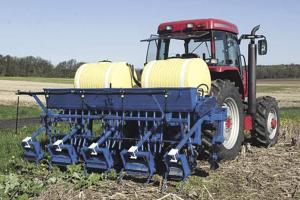2012 - Volume #36, Issue #2, Page #04
[ Sample Stories From This Issue | List of All Stories In This Issue | Print this story
| Read this issue]
Multi-Task With In-Crop Cover Crop Planter
 |
“We only did 4 rows for research purposes, but we have plans drawn up for a larger tool bar,” says Chris Houser, Penn State. “Some of the toolbars designed for side dressing would fit well. Making three applications in a single pass eliminates a major cost with cover crop seeding.”
The 4-row prototype is 3-pt. hitch-mounted. Liquid tanks for the fertilizer and herbicide mount over the toolbar. Seeding and applications are made in late June or early July.
“We apply the fertilizer at about 70 psi in a band about 4 in. to the side of the standing corn,” explains Houser. “The tillage throws some dirt over the band, but we hope to incorporate the band with future models.”
Primary tillage is provided by three, 2-in. wavy coulters spaced 4 to 5 in. apart in inner row units and 2 coulters each for the side rows. The 3 coulters create a 16-in. wide tilled area between the 30-in. row spacings. Each end unit tills 8-in. widths one way and the second 8-in. width on the return pass.
“The coulters break up the soil and slice through residue fine, yet leave enough residue to qualify as minimum till,” says Houser.
A Gandy box dribbles out seed at low rates across the tilled area. Ryegrass was seeded at around 20 lbs. to the acre, and clover was put on at only 7 to 10 lbs. per acre.
The seed was followed by a Penn State designed roller that ensures good seed to soil contact. A chain drag levels off any ridges.
“Our next generation will have more conventional cultipacker wheels,” says Houser. “Either way, rolling the seed gives us a more consistent stand, even with dry conditions.”
The planter has only been used for two seasons. This past year, it was tested on several area farms and in university research fields. Houser reports fast results with ryegrass which, when planted in late June or early July, was growing well by early September. Red and white clover and other cover crops were slower to take off, but were in good growth by early November.
“If you plant a cover crop here after harvest, it doesn’t have time to get much of any growth,” says Houser. “We had a ton of forage produced in the fall this year and a ton produced by spring last year. Combined with an estimated 3 tons of corn fodder, it made a good feed supply for grazing livestock.”
This past spring, corn was no-tilled in several areas that had been planted to cover crops. Houser reports that a burn-down herbicide application at planting eliminated the cover crop from competing. However, it continued to provide erosion control well into the season.
A video of the cover crop seeder in use can be viewed at www.farmshow.com.
Contact: FARM SHOW Followup, Chris Houser, Penn State University, Dept. of Crop and Soil Sciences, 116 ASI Building, University Park, Penn. 16802 (ph 814 692-7955; Cdh13@psu.edu; http://extension.psu.edu/cover-crops/cover-crop-interseeder-and-applicator).

Click here to download page story appeared in.

Click here to read entire issue
To read the rest of this story, download this issue below or click here to register with your account number.




